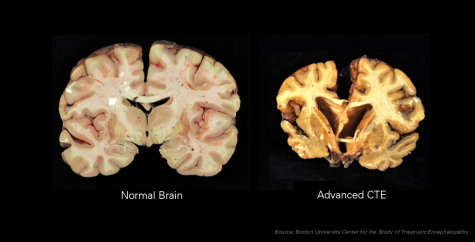CTE: a mind in prison
On Sunday, February 5th, 111.3 million people across the country tuned in to view Super Bowl LI as the New England Patriots and the Atlanta Falcons laid their hearts on the synthetic turf field of the NRG Stadium in Houston, Texas. Sheer determination was poured into each play as both teams risked it all in order for one to ultimately claim themselves as the Super Bowl LI champions. With each footstep placed onto the field, every single player not only risked potential humiliation by fans and critics, but more importantly, they came face to face with the most serious affair in the game– colliding with the ground or another player and encountering serious head trauma.
In 2015, researchers with the Department of Veterans Affairs and Boston University conducted a lab in which they diagnosed 87 deceased former National Football League (NFL) players with Chronic Traumatic Encephalopathy (CTE). Furthermore, “the lab has found CTE in the brain tissue in 131 out of 165 individuals who, before their deaths, played football either professionally, semi-professionally, in college or in high school,” according to the Public Broadcasting Service. Boston University’s Center for the Study of Traumatic Encephalopathy defines Chronic Traumatic Encephalopathy as a progressive degenerative disease of the brain found in athletes (and others) with a history of repetitive brain trauma, including symptomatic concussions as well as asymptomatic subconcussive hits to the head. While millions of everyday people are investing their energy into further understanding and preventing the development of CTE in the brain, one man in particular can be credited with first discovering this deadly disease: Nigerian-American physician, forensic pathologist, and neuropathologist, Doctor Bennet Omalu.
On Christmas Day of 2015, Concussion hit U.S. movie theaters by storm, seeing just over 23 million dollars in box office earnings. In this impressively informative drama, Dr. Bennet Omalu’s story of perseverance and questioning towards the NFL regarding the damage that had been done to football players who suffered from repetitive blows to the head which resulted in major concussions during their careers is portrayed by writer and director Peter Landesman. The brain of legendary Mike Webster, former Pittsburgh Steelers and Kansas City Chiefs player, was where Dr. Omalu first discovered CTE in the year 2002, which sparked an ember of interest in many. Since Dr. Omalu’s discovery, fellow neuropathologists, such as Dr. Ann McKee, have researched how mild traumatic brain injury in physical contact sports affects the brain.
CTE in particular carries with it severe repercussions that are irreversible once the damage is done. Each diagnosed case of CTE is distinct in its own ways depending on the human being that has it, however, many of these cases are associated with multiple horrors such as: loss of memory, confusion, incapacitated judgement, aggression, depression, and in some instances, dementia. The final stage of CTE, as reported by Dr. Ann McKee, is deformation of the brain and its cognitive functions. The brain’s approximate 100 billion neurons, or nerve cells, risk being killed while coping with CTE. Not only that, but Dr. Ann McKee has found that the brain can, in time, will shrink to ½ its normal size.
At the same time researchers and neuropathologists such as Dr. Ann McKee were contemplating ways that CTE can be prevented altogether on Super Bowl Sunday, Portage Northern’s football players were viewing the final game together in the igloo. When nearly half of the players were polled, only 6 out of 40 had some familiarity with the disease of Chronic Traumatic Encephalopathy. It is vitally important for every member involved in the game of football to be aware of the ways in which a player can safely participate in the game that is loved by many. Varsity football player Jack Haverdink (10), says “The biggest problem isn’t what the rules are, but how often the violations of the rules are spotted.” Haverdink’s words prove that all in all it is a collective effort to make the game a safe place for every player. Coach Schermerhorn’s mentality goes in a similar direction, exclaiming, “We want to make the game as safe as humanly possible, otherwise it is in danger of not existing anymore.”




